Specific crop-circles' forms
and the shape of the local Universe
4. Platonic solids
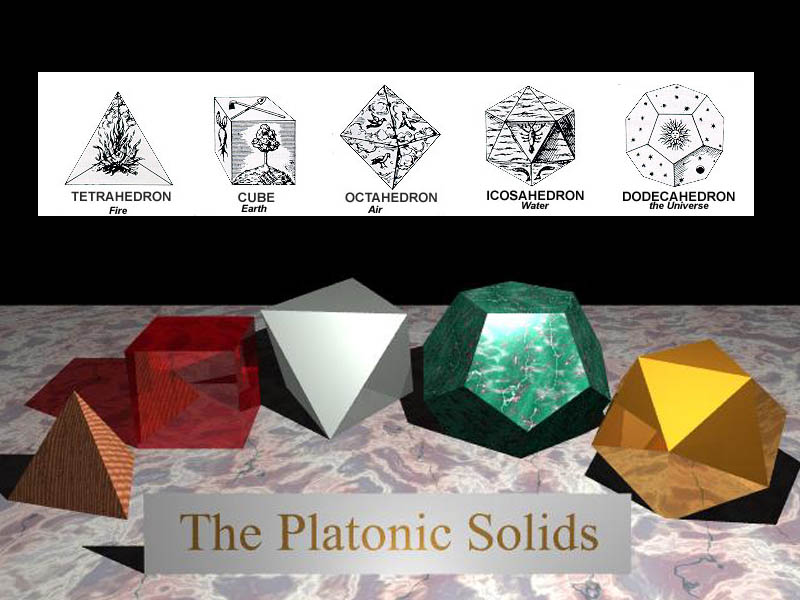 click
illustration by Jay Goldner
click
illustration by Jay Goldner
All the Platonic solids can fit exactly into spheres, and many of them can fit precisely into somewhat larger versions of each other.
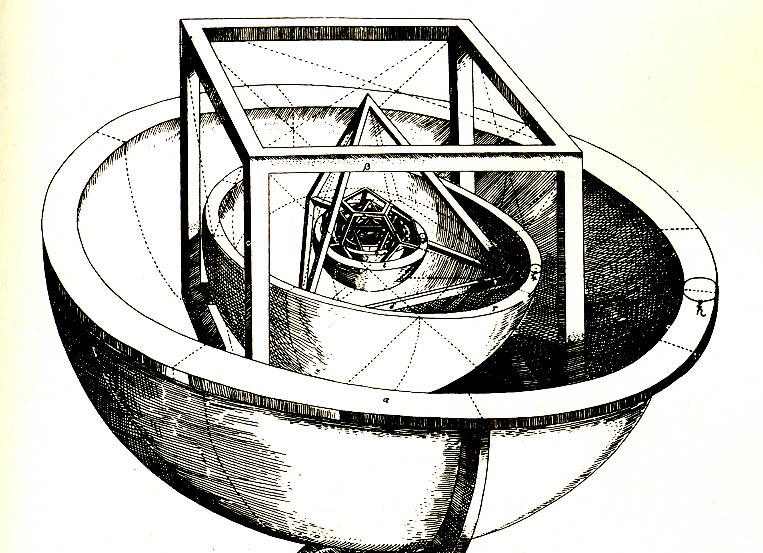 click
click
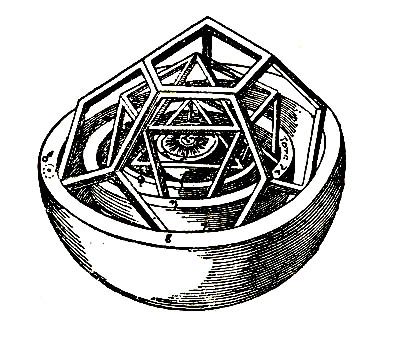 illustrations from John Martineau's "A little book of Coincidences"
illustrations from John Martineau's "A little book of Coincidences"
Kepler hypothesized that the orbital distances of the 6 closest planets to the Sun could contain shapes of the 5 Platonic solids between them. The planets' orbital elliptical variations would be contained within the thickness of the spherical shells separating them.
Octahedron
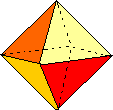 illustration from Enchanted Learning article
illustration from Enchanted Learning article
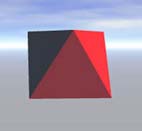
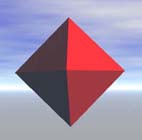
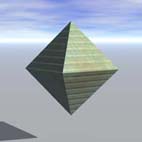 illustrations by Bert Janssen
illustrations by Bert Janssen
 illustrations from Eric W. Weisstein's octahedron article
illustrations from Eric W. Weisstein's octahedron article
An octahedron is a symmetric solid with 8 equilateral triangles as its surface. That is, a sort of pyramid with 4 sides, on top of an upside-down pyramid with 4 sides. The bottom middle figure is an octahedron with a square through it.
Tetrahedron
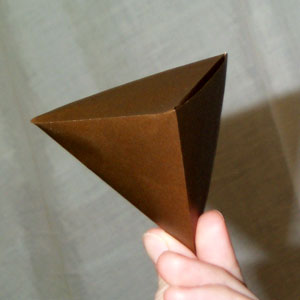 origami-illustration of a tetrahedon
origami-illustration of a tetrahedon
made by E. K. Herrstrom
photo from Kasahara and Takahama's book
 illustration from Enchanted Learning article
illustration from Enchanted Learning article
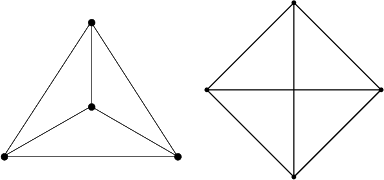
A tetrahedron is a symmetrical solid with 4 equilateral triangles on its surface. Like a pyramid with 3 sides and a base. It's the simplest 3-D symmetrical shape with straight lines - just as a triangle is the simplest 2-D likewise shape.
The diagrams above show three views of a tetrahedron. The first one, with the dotted line, is from a slanted sideways perspective. The second one depends on how you focus the central point - it can be both looking down the tetrahedron from above, or seeing its bottom surface and two sides, or seeing transparently through its front surface. The third view is seeing either the back surface or edge through two transparent sides - yet notice that it could also be an octahedron as seen from above!
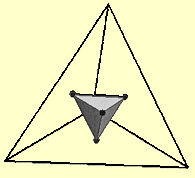
The tetrahedron is the only regular polygon (3-D shape with equal sides and angles on all its surfaces) which directly repeats itself on smaller planes. Connecting the midpoints of its sides reveals a touching smaller tetrahedron in its inner space, etc. etc.
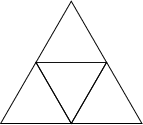
illustrations from Eric W. Weisstein's tetrahedon article
Seen from one of its sides, a tetrahedron looks like an equilateral triangle - which itself contains or implies four smaller equilateral triangles.
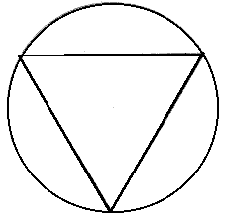
An equilateral triangle inside a circle: or a tetrahedron inside a sphere, as it's viewed from above.
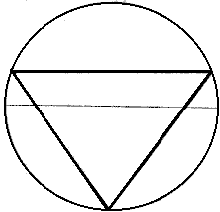 two illustrations by Jens Rowold
two illustrations by Jens Rowold
The same tetrahedron inside the same sphere, but viewed from its side, gives us this triangle inside the circle. It's upper corners are at the earlier mentioned 19.5 degrees above the sphere's "equator".
The ratios in both these illustrations are often found in crop-circle patterns containing triangles.
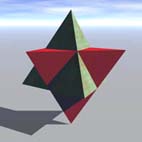 front view
front view
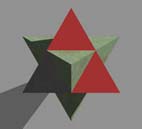 back view
back view
illustrations by Bert Janssen
Two tetrahedra can overlap and combine into a "star tetrahedron", which in its 2-dimensional form is the "Star of David" or "Seal of Solomon" (David's father), known for its subtle, esoteric levels of meanings.
Among other ways, one could see it as a connected system either at rest or moving in one direction. Or as the green tetrahedon spinning clockwise for example and the red counter-clockwise. Or as perpendiculars, with the green one revolving horizontally, while the red one revolves vertically.
As I understand Jens Rowald's references to Richard Hoagland and Stan Tenet's tetrahedral physics, the energy path from the center of a rotating sphere to its surface will take a spiral path creating a tetrahedron touching the sphere's surface. Perpendicular tetrahedra which rotate will make spiral energy, creating the electromagnetic lines along which dots of energy gather into matter. Rotating tetrahedra of different size scales will interlock.
It's said that energy from larger, rotating, more powerful planes, spirals inwards down to/through our atmosphere (forming a shape like an upside-down spinning pyramid), until it focuses at a point, and then spirals on outwards (like a counter-spinning erect-pyramid) to/through the ground. That the Eyptian pyramids, for instance, are thereby energy-focusers between the Earth and outer Space.
Likewise in the growth structure of a tree's leaf distribution or of its branches compared to its root-system, connecting the atmosphere with the underground. Fresh energy spirals into a pulsating, digesting, living organism, and saturated energy spirals out of it. Water also moves from larger to smaller in spirals, as down a bathtub or sink-plug hole.
5. Chilbolton tetrahedral fractal
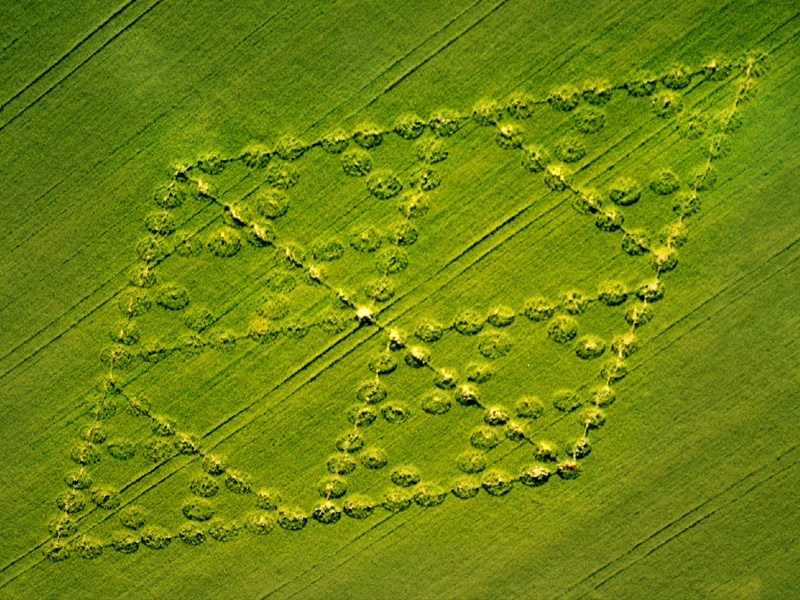 click
photo by Busty Taylor
Chilbolton, June 16, 1999
click
photo by Busty Taylor
Chilbolton, June 16, 1999
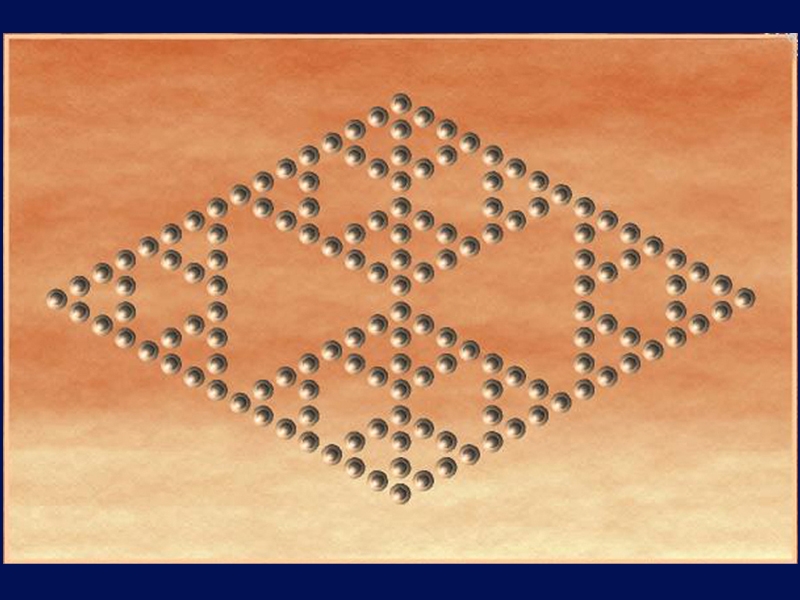 click
illustration by Ken Bakeman
click
illustration by Ken Bakeman
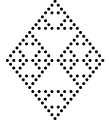
This shape or arrangment of componants was afterwards used in the technology of cell-phones. The crop-circle was both in the field beside, and also geometrically fits neatly into, the later famous Chilbolton "Face" and "E.T. code" crop-circles (the "code" formation describes an extraterrestrial being in detail).
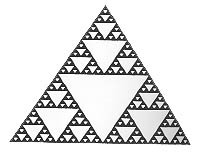 illustration by Nick Kollerstrom
Sierpinski Sieve fractal
illustration by Nick Kollerstrom
Sierpinski Sieve fractal
Extending the fractal, we get this triangle made of smaller triangles, or seen from above, a pyramid made of progressive levels of smaller pyramids.
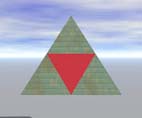
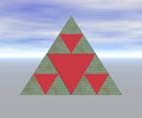
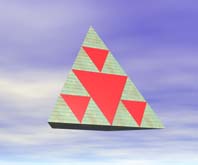 illustrations by Bert Janssen
illustrations by Bert Janssen
As we'll soon see, the red triangles inside the green can also represent a side-view of 3-D smaller octahedra embedded in a tetrahedron.
How else do octahedra and tetrahedra directly relate? If you place two octahedra beside each other with an edge in common, the wedge between them will be filled by a tetrahedron. So, if you take one big octahedron and fill it up with smaller octahedra with their edges touching, all the spaces between them will be filled up by tetrahedra.
6. Overton 3-D octahedron
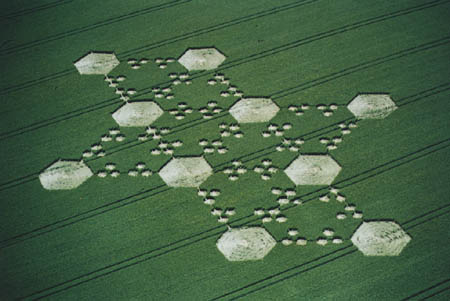 photo by Steve Alexander
West Overton, June 24, 1999
photo by Steve Alexander
West Overton, June 24, 1999
The smaller crop-circle shapes here were likewise hexagons, not circles.
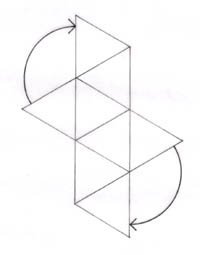
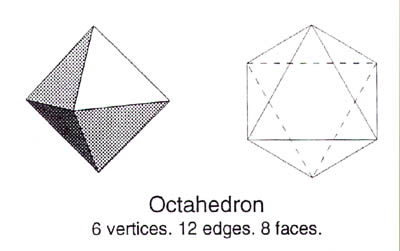 illustrations by Michael Glickman/ Patricia Murray
illustrations by Michael Glickman/ Patricia Murray
The difficulty with showing revolving solids in the fields' crop-circle symbols is that of representing 4 (or more) dimensions in 2 dimensions.
Taking the pathways alone from this crop-circle (putting aside its small hexagons for now and treating the large ones as mere points on lines), when we fold the lines together, we get a 3-D octahedron.
Notice that the 2-D view of an octahedron on the left gives a square, and on the right a hexagon, besides the triangle shape focused on until now.
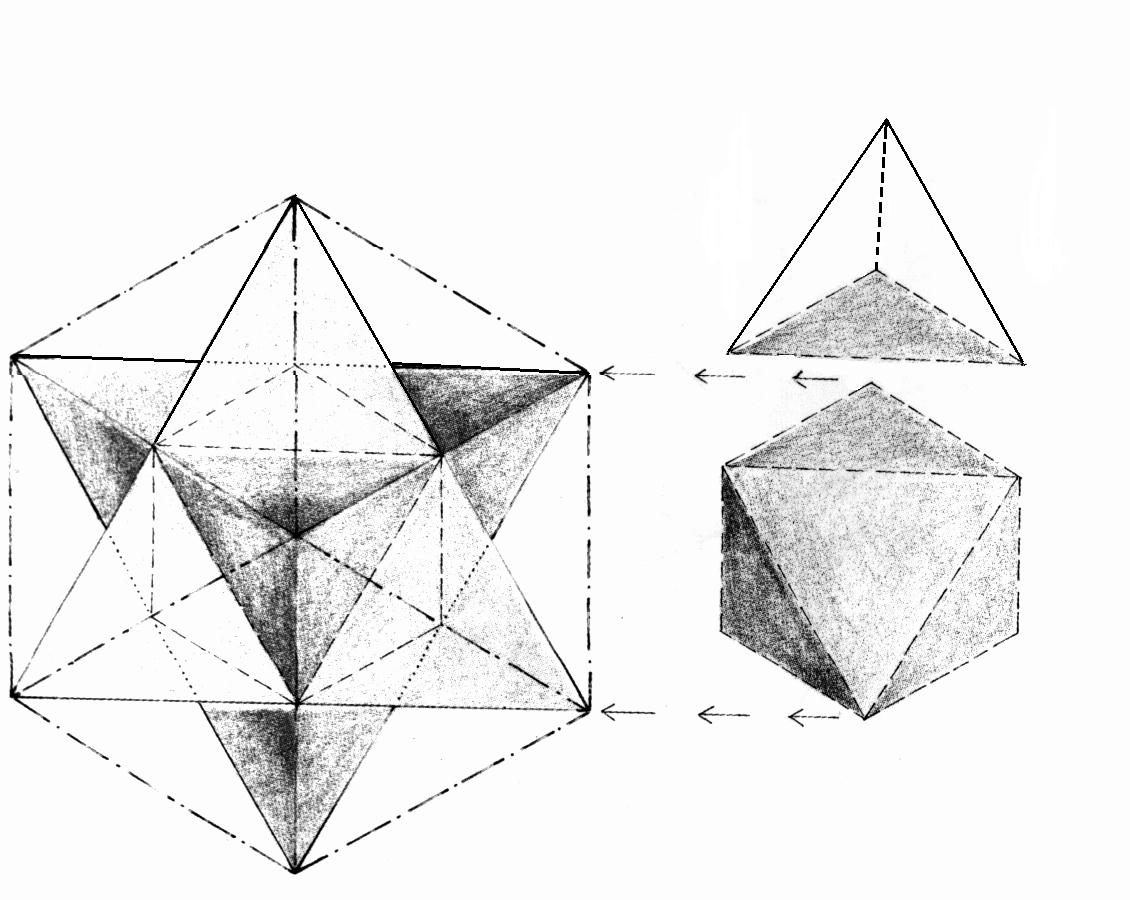
By adding a smaller tetrahedron to each side of an octahedron, we get a star-tetrahedron.
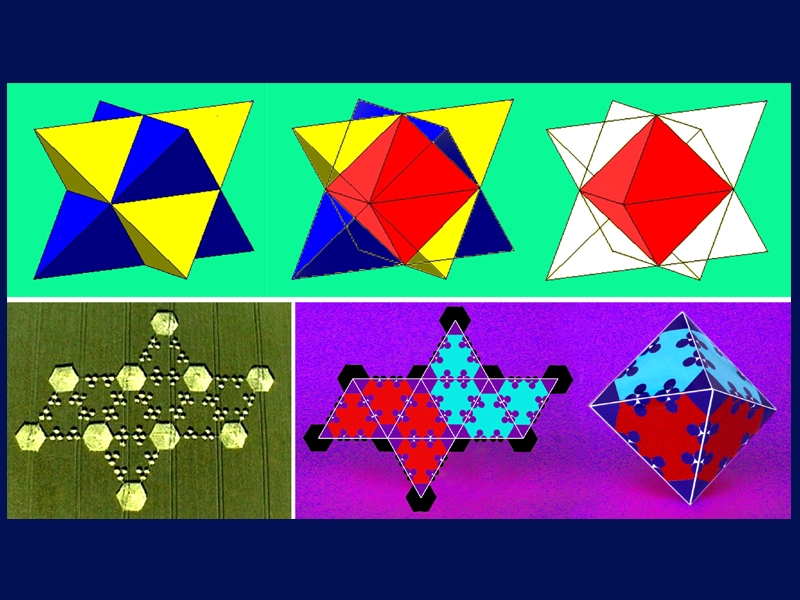 click
illustration by Jay Goldner
click
illustration by Jay Goldner
Now see how the crop-circle at bottom left, when folded into the octahedron, impressively incorporates the formation's large and small hexagons as reinforcing patterns along its edges and vertices.
Above that, as beautifully drawn here, see how an octahedron fits into the intersection-area of a star tetrahedron. Maybe on some scale the Universe's huge, newly discovered octahedra will turn out to be inside either such star tetrahedra or other symmetric Platonic solid shapes?
Continues in Part Three - click
 click
click click
click click
click












 front view
front view
 back view
back view click
click click
click








 click
click